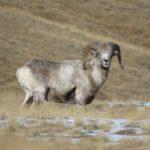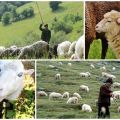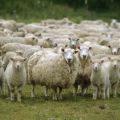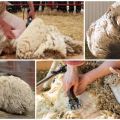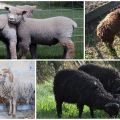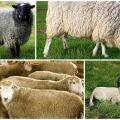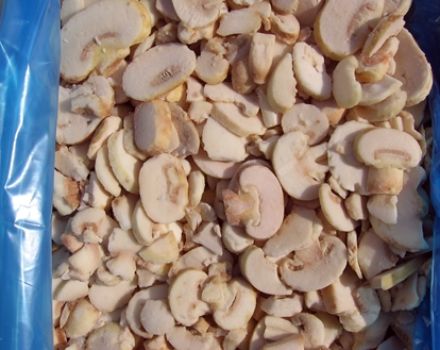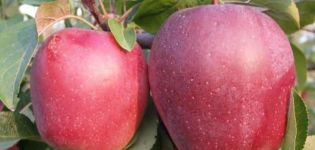From what animals came the sheep, who are the ancestors and where do their ancestors live?
Sheep are valuable pets. They have become a source of not only dairy and meat products, but also wool, on the basis of which clothes, shoes, and felt are made. Animals were domesticated several thousand years ago, there are many options for their origin. Consider who is the ancestor of the modern sheep, theoretical assumptions of domestication, where they live.
History of domestication
People were engaged in sheep breeding 8000 years ago. This is evidenced by the drawings found on the walls of the burial structures. 1000 BC e. used animal hair for fabrics. The first mentions of sheep were found in the writings of Aristotle. According to the characteristics described, the animal was similar to the modern Tsigai variety. Species with white wool were common in the territories of the Spanish, Greek, Italian states. From them are derived the now known merino. From the 19th century in France, farmers began to improve the characteristics of coarse wool sheep, obtaining a number of breeds familiar to farmers.
What animals did domestic sheep come from?
The first sheep came from wild species, but the exact source of origin is unknown. There are a number of breeds that are similar to domesticated relatives in conformation and performance.
Wild mouflon
It has such subtypes - European and Asian. Differs in good quality wool and original shape of horns, which hunters keep as a trophy. The ancestor of sheep has the following characteristics:
- height - up to 95 cm, length - up to 150 cm;
- short hair grows on a powerful body, the color changes seasonally: in summer - reddish, darkens by winter;
- black stripe along the back;
- the weight of females - up to 45 kg, males - up to 80 kg;
- powerful horns wrapped to the sides;
- life expectancy is about 15 years.

Argali
Listed in the Red Book, it is considered the largest species of mountain sheep. Description of the classic argali:
- height - up to 125 cm, length - up to 200 cm;
- a stately shortened body with a developed chest;
- the color is yellow or yellow-brownish, darkens in the cold season;
- the weight of the male sometimes reaches 200 kg, the female - 100 kg;
- sickle-shaped horns, total size - up to 60 cm;
- the approximate life span is about 15 years, in artificially created conditions the animal lives up to 18-20 years.

Argali
They are also called Altai mountain rams. Main characteristics of argali:
- height - up to 125 cm, length - up to 200 cm;
- the body is shortened, with thin but strong limbs;
- different color, from light red to brownish brown;
- dark stripes are located on the sides;
- the abdominal region and muzzle are lighter than the entire body;
- the weight of an adult male is up to 200 kg, of a female - up to 100 kg;
- horns are spiral-shaped, total length - up to 150 cm, weight - up to 35 kg, diameter - up to 55 cm;
- life expectancy is about 15 years.

Wild ancestor habitat
The wild ancestors of the sheep live in the highlands. They spend summer time on the slopes, in winter they go down to the foothills of the mountains. Habitat of animals:
- Mouflon. Lives on the mountainous Mediterranean coasts: Sardinia, Cyprus, Armenia, Corsica, Iraq.
- Argali. Distributed in Central Asia, in Mongolian, Kazakh territories, in mountainous Tibetan, Himalayan, Nepalese areas.
- Altai mountain sheep. Concentrated in the areas of mountain Altai, Tuvan, Mongolian massifs.
As a result of selection experiments of wild breeds and domestic sheep, healthy animals capable of living for a long time were bred, confirming the great possibility of kinship.
Origin theories
After a long study of the evolution of domestic sheep, experts disagreed. Some believe that only one representative is the ancestor - the mouflon. The rest suggest an affinity of sheep with several species, namely argali and argali.
During the research, significant differences were revealed between wild representatives and domestic sheep:
- Limb length. Domestic rams have short limbs, while wild ones are longer.
- Type of body structure. Wild rams are distinguished by a slender constitution with a well-defined muscular relief. The body of household representatives is round.
- Wool. Households have high quality soft fleece. In wild representatives, the coat is coarse, consisting of awn and dead hairs.
- Senses. In wild sheep, they are much more developed.
Differences between domestic sheep and their wild ancestors appeared as a result of evolution and selection work. The topic of the origin of sheep is still open. The work on finding the ancestors of the sheep continues.


